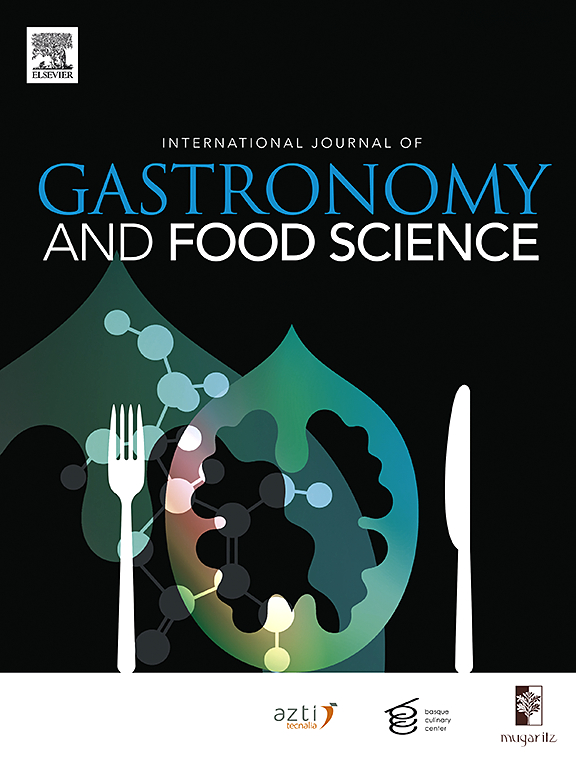旧食物,新形式:通过美食创新将传统产品多样化概念化的框架
IF 3.6
2区 农林科学
Q2 FOOD SCIENCE & TECHNOLOGY
International Journal of Gastronomy and Food Science
Pub Date : 2025-06-10
DOI:10.1016/j.ijgfs.2025.101225
引用次数: 0
摘要
发酵正经历着文化认同、健康、可持续性、社区建设和风味探索的复兴。随着传统食物在新的地方找到新的形式,我们需要找到一种方法,在区分其众多增殖形式的同时,对它们进行包容性的讨论——在重视传统的同时支持创新。为了应对这一挑战,我们引入了一个概念性框架,以分析和文化敏感的方式理解发酵创新。该框架由三个重叠的圆圈组成的维恩图组成,每个圆圈代表形成食品的一个关键因素:成分、工艺和感官特征(因此称为“三因素”或“3F”框架)。这三个因素的交集导致了七个分类领域-“传统”,“模拟”,“实验”,“故障”和;“本体创新”、“相关创新”、“相邻创新”和“复制创新”——通过它们如何以及在多大程度上偏离位于中心的传统产品来定义。在从理论上发展框架之后,我们将其应用于三个案例研究:味噌,garum和奶酪。总的来说,这个框架和它的应用表明,简单地构建世界的复杂性可以阐明新的模式,而不会过度简化它们,并且可以说明烹饪传统如何随着旅行和我们周围的世界的变化而变化。本文章由计算机程序翻译,如有差异,请以英文原文为准。
Old Foods, New Forms: A framework for conceptualising the diversification of traditional products through gastronomic innovation
Fermentation is experiencing a resurgence, for cultural identity, health, sustainability, community-building, and the exploration of flavour. As old foods find new forms in new places, there is a need for ways to discuss them alongside each other inclusively while differentiating their many proliferating forms— supporting innovation while valuing tradition. To address this challenge, we introduce a conceptual framework for understanding fermentation innovations in a both analytical and culturally sensitive way. The framework consists of a Venn diagram of three overlapping circles, each representing one key factor shaping a food product: ingredients, process, and sensory profile (henceforth ‘three-factor’ or ‘3F’ framework). The intersections of these three factors result in seven fields of categorisation—‘Traditional’, ‘Analogue’, ‘Experimental’, ‘Faults & Emic Innovations’, ‘Related’, ‘Adjacent’, and ‘Facsimile’—defined by how and how much they diverge from the traditional product at the center. After developing the framework theoretically, we apply it to three case studies: miso, garum, and cheese. Taken together, the framework and its applications show how lightly structuring the complexity of the world can illuminate new patterns without oversimplifying them, and can illustrate how culinary traditions change as they travel and as the world around us changes.
求助全文
通过发布文献求助,成功后即可免费获取论文全文。
去求助
来源期刊

International Journal of Gastronomy and Food Science
Social Sciences-Cultural Studies
CiteScore
5.30
自引率
10.50%
发文量
170
审稿时长
45 days
期刊介绍:
International Journal of Gastronomy and Food Science is a peer-reviewed journal that explicitly focuses on the interface of food science and gastronomy. Articles focusing only on food science will not be considered. This journal equally encourages both scientists and chefs to publish original scientific papers, review articles and original culinary works. We seek articles with clear evidence of this interaction. From a scientific perspective, this publication aims to become the home for research from the whole community of food science and gastronomy.
IJGFS explores all aspects related to the growing field of the interaction of gastronomy and food science, in areas such as food chemistry, food technology and culinary techniques, food microbiology, genetics, sensory science, neuroscience, psychology, culinary concepts, culinary trends, and gastronomic experience (all the elements that contribute to the appreciation and enjoyment of the meal. Also relevant is research on science-based educational programs in gastronomy, anthropology, gastronomic history and food sociology. All these areas of knowledge are crucial to gastronomy, as they contribute to a better understanding of this broad term and its practical implications for science and society.
 求助内容:
求助内容: 应助结果提醒方式:
应助结果提醒方式:


